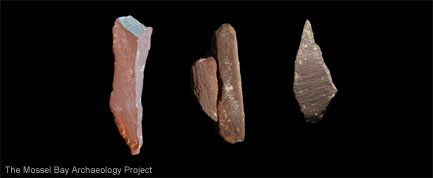
A band of early Homo sapiens survived an ancient bout of global cooling by hunkering down in a cave on the coast of South Africa and living off shellfish plucked from nearby tide pools, a new study suggests.
The cave overlooks the Indian Ocean, and inside it, scientists have found shellfish remains, a red pigment possibly used as body paint or dye, and stone "bladelets " about the size of an adult pinky finger that might have been attached to weapons.
Some of the shellfish and artifacts in the cave date to 164,000 years ago. The earliest previous evidence for humans living in coastal habitats dates to 125,000 years ago. Modern humans are thought to have first arisen between 150,000 to 200,000 years ago in Africa.
The finding, detailed in the Oct. 18 issue of the journal Nature, suggests the earliest members of our species were not only anatomically, but also behaviorally similar to modern humans that came later.
"What you see is 164,000 years ago, you have people collecting shellfish, they're collecting and modifying ochre almost certainly for symbolic behavior and they have advanced technology. That's very modern-looking," said study team member Curtis Marean of Arizona State University. "We can take that site and those materials and they would look perfectly at home in the Stone Age record 2,000 years ago."
The discovery also suggests that the first humans migrating out of Africa had already learned to live off the sea.
Prehistoric beach bums
Get the world’s most fascinating discoveries delivered straight to your inbox.
The shellfish remains and artifacts were discovered in a cave located in a South African coastal cliff called Pinnacle Point. About 100 feet (30 meters) deep and 30 feet (10 meters) wide, the cave was about as roomy as a large American home.
Marean estimates the cave housed five to 30 people at a time and thinks it was used repeatedly by different groups of people over a span of several thousand years.
"We know there were people in the cave about 164,000 years ago. We don't know how long, but perhaps that sequence lasted several hundred years," Marean told LiveScience. "Then there's another occupation, probably around 140,000 years ago. And then we have a fairly continuous occupation between 120,000 to 90,000 years ago."
Around 90,000 years ago, a large sand dune formed against the cliff face, sealing off the cave. But then 39,000 years ago, the cave broke "open once again, and there was a very short occupation at that point, and we don't think much of an occupation after that," Marean said.
Life's a beach
Among the items discovered in the cave were shells belonging to whelks, limpets and other mollusks. A fragment of a whale barnacle discovered at the scene also suggests the Pinnacle Point inhabitants scoured the beach for whale blubber and skin.
For thousands of years, human hunter-gatherers relied solely on land plants and animals for food, so the team speculates shellfish was a "famine food" consumed only in times of urgent need, perhaps in response to harsh environmental conditions.
"The world was in a glacial stage 125,000 to 195,000 years ago, and much of Africa was dry to mostly desert," Marean said. "In many areas, food would have been difficult to acquire. The paleoenvironmental data indicate there are only five or six places in all of Africa where humans could have survived these harsh conditions."
The South African coasts would have been an ideal place to camp out, Marean said, because a current from the Indian Ocean, called the Agulhas Current, would have kept the coastline environment there warm even during a glacial period.
A crucial skill
In addition to shellfish remains, the cave also contained 57 pieces of hematite , an iron ore that can be ground up to produce a blood-red pigment called red ochre. Some of the hematite pieces showed scratch marks. These marks might have aided grinding to make color dyes or body paints, served as a form of decoration in themselves or might even have functioned as a kind of early notation system, scientists say.
"The Pinnacle Point evidence is significant because it suggests that early humans in Africa inhabited a cognitive world enriched by symbols before 160,000 years ago," Sally McBrearty and Chris Stringer, researchers at the University of Connecticut and the Natural History Museum in London, respectively, who were involved in the study, write in a related Nature article.
The significance of the stone bladelets is still unclear, but other prehistoric peoples living much later are known to have used similar stone chippings as weapons.
"These could be attached to the end of a stick to form a point for a spear or lined up like barbs on a dart," Marean said.
The ability to exploit the sea might have been what allowed humans to spread around the world. Other scientists have speculated that the ability to survive on shellfish allowed earlier humans to migrate out of Africa about 120,000 years ago via a route that hugged the coastline of the Red Sea.
The Pinnacle Point discovery shows humans had already adapted to a coastal lifestyle thousands of years earlier.
"Coastlines generally make great migration routes," Marean said. "Knowing how to exploit the sea for food meant these early humans could now use coastlines as productive home ranges and move long distances."
- Top 10 Missing Links
- Hit the Beach: Why Humans Love Water
- Timeline of Human Evolution
